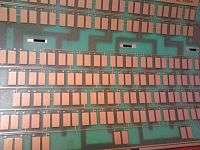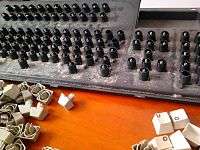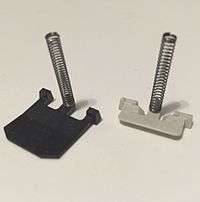Model F keyboard
The Model F was a series of computer keyboards produced from 1981–1994 by IBM and later Lexmark.[1] Its mechanical-key design consisted of a buckling spring over a capacitive PCB, similarly to the later Model M keyboard that used a membrane in place of the PCB.
The Model F first appeared with the IBM System/23 Datamaster all-in-one computer. It is best known as part of the IBM Personal Computer in 1981 with some keycap label differences, and its subsequent release with the IBM Personal Computer/AT, where it was reconfigured with the AT protocol and some layout revisions.[2][3]
The capacitive design is widely considered superior to that of the later membrane design used on the Model M. It has a lighter actuation force of about 600 mN, a crisper feel and louder feedback, and is more robust. It also has a higher MTBF of over 100 million keypresses, and full n-key rollover.
Variations
Many IBM keyboards were based on Model F technology, featuring different keycaps, layouts and connections:
| Name | PN | Description | Image |
|---|---|---|---|
| Model F 'XT' | 1801449 | Released in 1981 with the original IBM PC. Uses an XT connector. |  |
| Model F 'AT' | 6450200 (US version) [4] | Released in 1984 with the IBM PC AT. Uses an AT connector. |  |
| Model F '122-key terminal keyboard' | 611034x | Terminal keyboard released for the IBM PC 3270. Uses an IBM proprietary terminal connector. |  |
| Model F '104-key terminal keyboard' | 1387033 | Terminal keyboard released for the IBM 5085 and IBM 3290.[5] | |
| Model F '4704 62-key' | 6019284 | 62-key keyboard released for the IBM 4704[6] | |
| Model F '4704 107-key' | 6020218 | 107-key keyboard released for the IBM 4704 | |
| Model F '4704 50-key' | 6019273 | 50-key keypad released for the IBM 4704 | |
| Model F 'Displaywriter' | ? | Keyboard released for the IBM Displaywriter System,[7] these Model F keyboards featured fully white keys. |
Design


The Model F's key-switch design was more durable than IBM's previous beam-spring mechanism, which was prone to failure from debris and was more complex to manufacture and service.[11] The spring assembly consisted of a top metal plate with cut holes where the plastic spring barrels reside; a bottom sheet of metal then holds the assembly together and compresses the contact sheet with a foam spacer. Earlier Model F keyboards cannot have their space bars removed without disassembling the internal assembly, this also causes a slightly different feel response from the space bar specifically: some enthusiasts modify the tension of the stabilizer on these early Model F keyboards to provide a more satisfactory response.[12]
The top metal plates in Model F keyboards are prone to corrosion and the internal foam can also rot from age, which often requires cleaning and a coating to prevent further corrosion. All Model F internal assemblies are held together with metal tabs, unlike the Model M which uses melted rivets requiring more rivets to be melted on or modified with bolts.[13]
A characteristic feature of the Model F is a plastic top shell painted with a cream paint to create a rough texture. The later Model M keyboards used injection plastic rather than paint to achieve this texture. The plastic used in the Model F is quite brittle and prone to hairline cracks, and the paint can wear off from excessive use.
Comparison with Model M

Although the Model F and Model M are both based on buckling-spring technology, there are considerable differences between them:
| Model F | Model M | |
|---|---|---|
| External chassis | Painted plastic (zinc metal in the 4704 series) and steel metal back panel (plastic in the F AT and zinc metal in the 4704 series) |
Molded (unpainted) plastic, plastic back panel |
| Internal stabilizer | Only in early models | |
| Buckling spring implementation | Capacitive plate | Plastic membrane |
| Key rollover | Unlimited | 2-key rollover[14] |
| Assembly method | Reusable metal tabs | Single-use rivets |
| Spring barrels | Individually inserted in a metal plane | Single plastic mold with predefined barrels |
See also
References
- http://deskthority.net/wiki/IBM_Model_F
- http://deskthority.net/wiki/IBM_Model_F#IBM_System.2F23_Datamaster_Keyboard
- Bradley, David J. (September 1990). "The Creation of the IBM PC". BYTE. pp. 414–420. Retrieved 2 April 2016.
- https://deskthority.net/wiki/IBM_Model_F#IBM_Personal_Computer_AT_keyboard
- http://deskthority.net/wiki/IBM_Model_F#IBM_104-key_Model_F_Keyboards
- http://kishy.ca/?p=894
- http://deskthority.net/wiki/IBM_Model_F#IBM_Displaywriter_Model_F_Keyboard
- Limer, Eric (5 July 2017). "The Best Keyboard Ever Is Back". Popular Mechanics.
- Killian, Zak (6 July 2017). "Model F keyboard gets a modern reboot". The Tech Report.
- Strandberg, Joe. "Brand New Model F Keyboards". Retrieved 2017-07-08.
- http://deskthority.net/wiki/Beam_Spring#Maintenance_issues
- http://deskthority.net/workshop-f7/model-f-improvement-dis-assembly-tips-and-space-bar-mod-t6982.html
- http://wiki.geekhack.org/index.php?title=Modifications:IBM_Model_M:Nut_and_Bolt_Mod
- https://www.reddit.com/r/MechanicalKeyboards/wiki/nkro
External links
- Model F Labs – current Model F manufacturer.